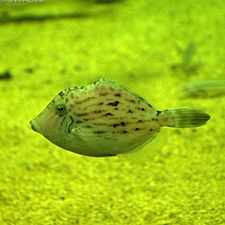Stephanolepis cirrhifer
| Stephanolepis cirrhifer | |
|---|---|
 | |
| Stephanolepis cirrhifer | |
| Scientific classification | |
| Kingdom: | Animalia |
| Phylum: | Chordata |
| Class: | Actinopterygii |
| Order: | Tetraodontiformes |
| Family: | Monacanthidae |
| Genus: | Stephanolepis |
| Species: | S. cirrhifer |
| Binomial name | |
| Stephanolepis cirrhifer (Temminck & Schlegel, 1850)[1] | |
| Synonyms | |
| |
Stephanolepis cirrhifer, commonly known as the threadsail filefish, is a species of marine fish in the family Monacanthidae. It is found in the western Pacific, in an area that ranges from northern Japan to the East China Sea. The fish grows to a maximum length of about 12 inches (30 centimetres), and is sold commercially for food and culinary purposes in many Asian countries.[2][3]
Taxonomy
The fish was first described in 1850 by Coenraad Jacob Temminck and Hermann Schlegel, when it was observed along with other fauna off the coasts of Japan. They initially placed it in the genus Monacanthus, as Monacanthus cirrhifer; it was transferred to Stephanolepis by Jordan and Fowler in 1903.[1][4][5] The species name cirrhifer is from the Latin meaning "bearing fringes of hair".[6]
Description and habitat
Threadsail filefish grow to a maximum adult length of about 30 centimeters (12 inches). They have a slight fin on the dorsal side, are colored from light brown, to grayish- to light greenish-beige, and are slightly patterned with irregular, broken stripes that range from medium brown to blackish. Juveniles of the species usually seek shelter and safety from predators within clusters of drifting seaweed. The adult threadsail filefish usually reside near the seabed, where the depth is around 10 metres (33 feet). The fish migrate wholly in ocean waters ("oceanodromous") between their feeding and spawning grounds, which can cover a range of over 100 kilometres (62 miles).[2][3][7]
Ecology
The threadsail filefish is an omnivore, and can feed on plant or animal matter. Its diet includes kelp, but consists mainly of amphipods such as gammarids and skeleton shrimp, as well as the seagrass species Zostera marina.[2] The fish also feeds upon smaller organisms, including bryozoans and some species of serpulid tube worms.[8]
Parasites
The threadsail filefish is host of the pennellid copepod parasite Peniculus minuticaudae Shiino, 1956 (Copepoda: Siphonostomatoida). The complete life cycle of this parasite has been described [9] from cultured fish in Japan. It consists of six stages separated by moults: the copepodid, four chalimi and adult.
Uses
The threadsail filefish is sold commercially as food in Asian countries, including Korea and Japan.[3][10] The demand for the fish in Korea is very high, and fisheries often employ the services of fish hatcheries for breeding more of the fish to supplement and enhance the supply of stock. This has been done to such a degree that some genetic differentiation between S. cirrhifer caught in the wild and those bred in a hatchery has occurred. As many as 95 alleles have been found to be unique to one of the populations, resulting from minor polymorphisms (variations) in certain genes that occur exclusively within either population.[10]
References
- ↑ 1.0 1.1 Bailly, Nicolas (2008). "Stephanolepis cirrhifer (Temminck & Schlegel, 1850)". World Register of Marine Species. Retrieved January 11, 2012.
- ↑ 2.0 2.1 2.2 Stephanolepis cirrhifer. Encyclopedia of Life. Retrieved January 11, 2012.
- ↑ 3.0 3.1 3.2 "Stephanolepis cirrhifer". Marinelifephotography.com. Retrieved January 11, 2012.
- ↑ Jordan, D.S.; Fowler, H.W. (1903). "A Review of the Trigger-fishes, File-fishes, and Trunk-fishes of Japan". Proceedings of the United States National Museum 25: 251–286. doi:10.5479/si.00963801.25-1287.251. Retrieved January 11, 2012.
- ↑ "Stephanolepis cirrhifer (Schlegel & Temminck 1850)". Fishwise. Retrieved January 11, 2012.
- ↑ Jordan and Fowler (1903), p. 265.
- ↑ Journal of the Faculty of Science, Hokkaido University: Zoology 14. Hokkaido University. 1958. Retrieved January 11, 2012.
- ↑ Publications from the Amakusa Marine Biological Laboratory, Kyushu University 1–3. Kyushu University. 1966. p. 22. Retrieved January 11, 2012.
- ↑ 9.0 9.1 Ismail, N.; Ohtsuka, S.; Venmathi Maran, BA.; Tasumi, S.; Zaleha, K.; Yamashita, H. (2013). "Complete life cycle of a pennellid Peniculus minuticaudae Shiino, 1956 (Copepoda: Siphonostomatoida) infecting cultured threadsail filefish, Stephanolepis cirrhifer.". Parasite 20: 42. doi:10.1051/parasite/2013041. PMID 24165196.
- ↑ 10.0 10.1 An, H. S.; Hong, S. W.; Kim, E. M.; Myeong, J. I. (2011). "Comparative genetic diversity of wild and hachery populations of Korean threadsail filefish Stephanolepis cirrhifer using cross-species microsatellite markers". Genes & Genomics 33 (6): 605. doi:10.1007/s13258-011-0109-y.
_Complete_life_cycle_of_a_pennellid_Peniculus_minuticaudae_-fig8.tif.jpg)